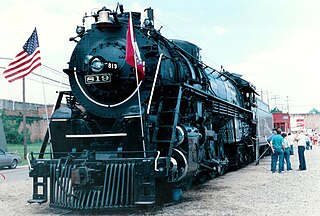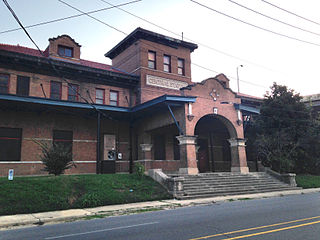
The St. Louis–San Francisco Railway, commonly known as the "Frisco", was a railroad that operated in the Midwest and South Central United States from 1876 to April 17, 1980. At the end of 1970, it operated 4,547 miles (7,318 km) of road on 6,574 miles (10,580 km) of track, not including subsidiaries Quanah, Acme and Pacific Railway and the Alabama, Tennessee and Northern Railroad; that year, it reported 12,795 million ton-miles of revenue freight and no passengers. It was purchased and absorbed into the Burlington Northern Railroad in 1980. Despite its name, it never came close to San Francisco.

The St. Louis Southwestern Railway Company, known by its nickname of "The Cotton Belt Route" or simply "Cotton Belt", is a former Class I railroad that operated between St. Louis, Missouri, and various points in the U.S. states of Arkansas, Tennessee, Louisiana, and Texas from 1891 to 1980, when the system added the Rock Island's Golden State Route and operations in Kansas, Oklahoma, and New Mexico. The Cotton Belt operated as a Southern Pacific subsidiary from 1932 until 1992, when its operation was assumed by Southern Pacific Transportation Company.

The Central of Georgia Railway started as the Central Rail Road and Canal Company in 1833. As a way to better attract investment capital, the railroad changed its name to Central Rail Road and Banking Company of Georgia. This railroad was constructed to join the Macon and Western Railroad at Macon, Georgia, in the United States, and run to Savannah. This created a rail link from Chattanooga, on the Tennessee River, to seaports on the Atlantic Ocean. It took from 1837 to 1843 to build the railroad from Savannah to the eastern bank of the Ocmulgee River at Macon; a bridge into the city was not built until 1851.
Bird's Point is an unincorporated community in Mississippi County, Missouri, United States. It lies on an island or former island in the Mississippi River, near the confluence of the Ohio and Mississippi Rivers and is situated directly across from Cairo, Illinois. This is the point where the U.S. Route 60 bridge connects with Cairo.

Idalia is an unincorporated community in Stoddard County, Missouri, United States. It is located six miles northeast of Dexter.

The Virginia Museum of Transportation is a museum devoted to the topic of transportation located in Downtown Roanoke, Virginia, US.

Little Rock Union Station, also known as Mopac Station, is a train station in Little Rock, Arkansas, United States served by Amtrak, the national railroad passenger system.

Texarkana Union Station is a historic train station in the Texarkana metropolitan area serving Amtrak, the United States' national passenger rail system. The Arkansas-Texas border bisects the structure; the eastern part, including the waiting room and ticket office, are in Texarkana, Arkansas, but the western part is in Texarkana, Texas, meaning stopped trains span both states. The station was built in 1928 and was added to the U.S. National Register of Historic Places in 1978. Today it is the second busiest Amtrak station in Arkansas.

The Lick Skillet Railroad Work Station Historic District is a historic district in Brinkley, Arkansas that was listed on the National Register of Historic Places in 1992.

St. Louis Southwestern No. 819 is a class "L1" 4-8-4 "Northern" type steam locomotive and is also the official state locomotive of Arkansas. It was completed in 1943 and was the last engine built by the St. Louis Southwestern Railway, which was affectionately known as "The Cotton Belt Route" or simply "Cotton Belt". It was also the last locomotive built in Arkansas. It was restored to operating condition in 1986 and operated in excursion service until October 1993. As of 2022, the locomotive is now located at the Arkansas Railroad Museum, currently being cosmetically restored.

Arkansas Railroad Museum is located on Port Road in Pine Bluff, Arkansas at the former Cotton Belt (SSW) yard.

The Morning Star was a passenger train operated by St. Louis Southwestern Railway between St. Louis and Dallas, designated as train numbers 5 (southbound) and 6 (northbound). From 1941 to 1950, the Morning Star also carried through cars from Memphis to Dallas, connecting with the main train at Brinkley, Arkansas. The Memphis connection for the Morning Star was added to permit Cotton Belt passenger trains to readily connect with the new Tennessean which had been inaugurated by Southern Railway in 1941. The Morning Star was replaced by unnamed train numbers 7 and 8 in November 1952, as a part of extensive passenger train restructuring by St. Louis Southwestern. The #7/#8 trains continued to the mid-1950s along the St. Louis - Dallas route, with coach and sleeping car service; however, food concession cars were eliminated.

Shreveport Central Station is a historic train station in Shreveport, Louisiana. It was built in 1910 by the Louisiana and Arkansas Railroad, a railroad that was eventually acquired by the Kansas City Southern Railway. By the opening of the 1940s the L&A and the St. Louis Southwestern Railway or 'Cotton Belt' moved its passenger operations from Central Station to Shreveport Union Station.

St. Louis–San Francisco 4003 is a 2-8-2, Mikado type, standard gauge steam railway locomotive built by the American Locomotive Company in 1919 as a standard USRA Light Mikado for the Pennsylvania Railroad. The PRR, for unknown reasons, rejected 33 of 38 locomotives in the order. The United States Railroad Administration reassigned 23 of them to the St. Louis–San Francisco Railway (SLSF), also known as the "Frisco". The Frisco also received 10 sisters from the Indiana Harbor Belt Railroad, making 33 in all. The locomotive is now on display at the Fort Smith Trolley Museum in Fort Smith, Arkansas.

The Cotton Belt Freight Depot is a former freight depot of the St. Louis Southwestern Railway in the Near North Riverfront neighborhood of St. Louis, Missouri. It was listed on the U.S. National Register of Historic Places in 2004 and named "Best Old Building" by the Riverfront Times, a weekly newspaper in St. Louis.

The Cotton Belt Depot Museum is a museum located in the historic railroad depot in Tyler, Texas.

Union Station is a former railroad station at East 4th Ave. and State St. in Pine Bluff, Jefferson County, Arkansas. The station was originally at the union of the Cotton Belt and Iron Mountain railroads, and now houses the Pine Bluff/Jefferson County Historical Society museum. It is a single-story brick building, with a hip roof whose long eaves are supported by iron columns and half-truss brackets. The station was built in 1906 by the Iron Mountain Railroad. It had been a stop on the St. Louis Southwestern's Lone Star (Memphis-Dallas), and also on the railway's St. Louis-Dallas trains.

The Cotton Belt Railroad Depot is a historic railroad station at the junction of Main and 1st Streets in downtown Fordyce, Arkansas. The single-story brick building was built c. 1925 by the St. Louis Southwestern Railway, also commonly known as the Cotton Belt Railroad. The building is predominantly Craftsman in its styling, with extended eaves that have elaborately styled brackets.
The St. Louis Southwestern Railway Caboose #2325 is a historic railroad caboose. It was built in 1920 by the St. Louis Southwestern Railway at its Pine Bluff, Arkansas shop, and is one of only a few surviving 2300-series cabooses. It was used by the railroad on its Paragould-Blytheville route, and was acquired by the Paperton Junction Southern Railway in 1980 and restored.

The St. Louis Southwestern Railway Steam Locomotive #336 is a historic railroad steam locomotive, located at the Arkansas Railroad Museum in Pine Bluff, Arkansas. It is a Class D3 2-6-0 Mogul-style locomotive, built in 1909 by the Baldwin Locomotive Works in Philadelphia, Pennsylvania. She served on the St. Louis Southwestern Railway until 1947, and served industrial customers until 1963. It was placed on display in Lewisville, Arkansas until 1994, when it was donated to the museum. It is the last remaining 330-series locomotive used by the Cotton Belt.



















